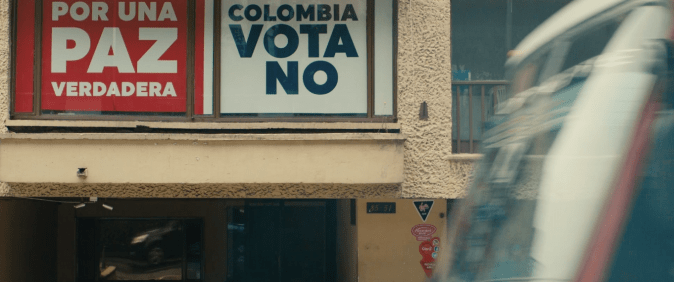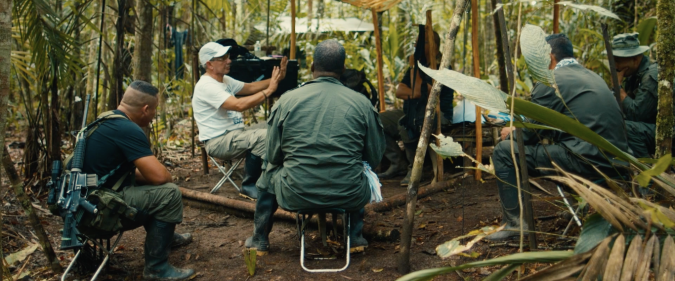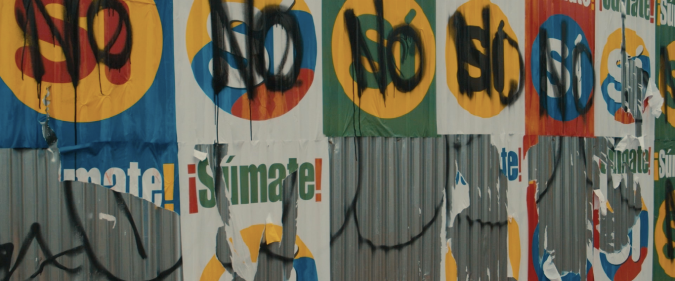From the contentious talks in Cuba to a surprising Nobel Peace Prize win timed with a shocking public referendum rejecting a nearly done peace agreement between the government and the Fuerzas Armadas Revolucionarias de Colombia (FARC), the journey towards ending the decades-long conflict in Colombia was bound to get the cinematic treatment. Enter Marc Silver. The director of the Gael García Bernal flick Who is Dayani Cristal? may not have delivered the kind of PBS info-doc you’ll need to catch up on the fifty-year armed conflict but To End a War is a play-by-play account of the months leading up to the divisive and embattled peace referendum that shocked the world.
Silver and his team spent close to three years shooting the film in Colombia as well as in Havana, where the peace talks were taking place. Originally, Silver envisioned the film tracing the tensions between the FARC and the government. But, the more he read and researched and shot, he realized that those two camps were actually united in the same goal: signing a peace agreement. The tension eventually came instead from former President Alvaro Uribe who led the No campaign, urging and echoing calls to disavow the terms settled on by President Juan Manuel Santos and the FARC leadership. As we see in Silver’s film, which plays like a political thriller (think No, Primary Colors and Our Brand Is Crisis), the heated debate leading to the historic vote just revealed generational, geographic, and cultural differences in a country deeply divided over how to not just end a war but dream of peace. With unfettered access to the government and the FARC, no boring talking heads lecturing you while staring straight at the camera, and some stunning cinematography that makes his film look more gorgeous than a doc about war has any right to be, Silver and his team have created a primer for those interested in recent Colombian history.
Following a screening of the doc at the United Nations—hosted by the Colombian ambassador to the UN, no less—Remezcla caught up with Silver. The director shared what it is that first drew him to the project, how the referendum changed the way he’d first envisioned his take on the Colombian conflict, and why making To End a War not feel like a history doc was so important to him. Check out highlights from our chat below.
On the Shock of Seeing the ‘No’ Campaign Win
“The presumption was, much like with Brexit and maybe with Trump, that it would’ve never happened.”
It’s a shame actually, because obviously the presumption was, much like with Brexit and maybe with Trump, that it would’ve never happened. So when it dropped it was extremely shocking to the people involved but also to us, in terms of the narrative of the film. One consequence was that we had to backtrack through the film and increase the time so the audience could experience the evolution of the No campaign. But more importantly for me is a real shame but we asked many times to have access to Uribe and the No campaign over the course of the film in the same way that we had access to the FARC and the government. And basically that side wouldn’t come on board. They wouldn’t be in the film unless we simply we put an uncut interview with Uribe, which of course is not possible in a documentary. So I’ve always felt slightly—I’ve watched the film and I’d like more from Uribe and the No campaign, particularly because I think audiences really desire to understand what their journey to winning the plebiscite. I don’t think it was anything specific to us. But I think it was just this kind of their way of understanding and working with the media—unless he is in control of his presentation, he’s not willing to let the media essentially have control of him. I mean that in terms of editorial.

On Bringing the FARC On Board
[The producers] secured access more with the Presidency and then when I came on board I went to meet with the FARC in Havana at that time. I showed them past films I’d made and discussed my style of filmmaking. Showed them that it is not traditional Colombian-media type of filmmaking, which they were obviously very wary of in terms of the propaganda war that’s been going on there for years. After we had those sorts of conversations, they came on board.
On Accurately Capturing the Colombian Conflict
It was overwhelming! It was extremely difficult at the beginning to get a sense of what in those 50 years was important to get over. What was difficult in the edit was: at what point are we giving too much information to the audience? And at what point are we not giving enough information to the audience? Because you really don’t understand the importance of the peace process unless you understand the magnitude of the history. Equally, we’re not making a talking heads/historical film, of which there are many on Colombia—so there wasn’t a need for that. That’s not the film that I would make. I don’t need to make that. It was a fine line between allowing an audience enough information to understand the importance of the peace process without drowning them in history. It took, I would say, many many passes in the edit to get that right. In some scenes, like in Bojayá where the church was bombed accidentally by the FARC, that was interesting to us because it talked about something that’s happening but that you don’t really realize this importance in the present unless you understand the complexities of the past. We were also in the journey of making this film, looking for moments in the present that allowed us to talk about the history. Mainly because of the self-imposed rule that we didn’t have talking heads explanations.

On Using a Journalist as a Narrative Entry Point
At some point we were looking for a device, if you like, a way to find an entry point and someone who could act as a guide to this very full-on 50 years of history and very full-on 4 year process of peace. So we came up with the idea like, could a journalist fulfill that role as a character? And then once we had met with [Jorge Enrique] and understood his journey, what I came to learn over the course of the film was that his story was almost a microcosm or metaphor for many of the people’s understanding of Colombia. In the sense that the presumptions that were made about him and suffered for trying to tell the story of the FARC—by the end of the film, he’s a very authentic, his reasons for wanting to get to a version of the truth were totally believable and authentic. In many ways, he came to represent, in the eyes of the Colombian public, he was considered to be the voice of terrorists. But for someone like me, who doesn’t come from Colombia, that would be the same as saying just because I want to make a film about the ISIS leadership, that in some way I am the voice of ISIS. But I think because of the sort of chaos theory that unfolded around 50 years at war—which is completely understandable—the Colombian public are never really aware of what is the truth underneath all of this multiple layers of chaos and propaganda—essentially, stories upon stories upon stories. I felt, over the course of editing, that Jorge Enrique was a sort of metaphor for all those many many layers of propaganda.

On the Reaction to His Film
I was actually really surprised and moved when I went to the premiere in Bogotá. I think we thought we were making a film for people who didn’t know a lot about Colombia as in, a foreign audience. So I wasn’t expecting Colombians to—I didn’t know what to expect from Colombians. The screening that I went to was amazingly cathartic. I think audiences felt it was cathartic and it was super emotional. I realized when I was watching it on the big screen in Colombia that the intimacy of the camerawork that allowed us to see Timochenko and the other members of the FARC really sort of broke down the iconography that they had become in the media. I think those things were very helpful in provoking conversations about the disparity between people’s mediated knowledge of the FARC, the government, the Presidency, and what had really been going on during the peace process.
On What’s Next
Interesting. As a filmmaker, I think it’s going to get very interesting over the next two years to sort of understand this whole “ending a war.” A huge amount of time, money, and effort went into ending a war for all those involved. But how do you really deal with peace? For me, that, in many ways is the axis of the film. And really, that is the reality that people are going to be living with, as opposed to the kind of signing and the handshake [you saw] in Havana.




